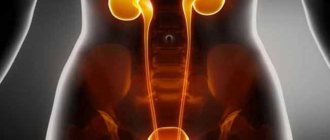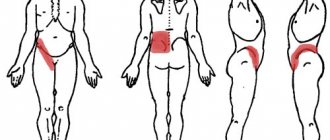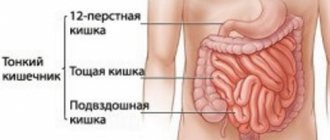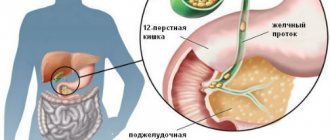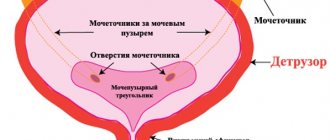Description of the disease
Chronic kidney disease (CKD) is a long-term disease in which the kidneys do not work as well as normal. Their function is reduced for 3 or more months.
CKD usually does not cause any symptoms until it reaches an advanced stage. In earlier stages, the disease is detected using blood and urine tests. The main symptoms of progressive kidney disease are:
- fatigue;
- swollen ankles, feet or hands (due to water retention);
- shortness of breath;
- nausea;
- blood in urine.
Kidneys
The kidneys are two bean-shaped organs located on the sides of the body, just below the rib cage. The kidneys' main role is to filter waste from the blood before turning it into urine. Kidneys also:
- help maintain blood pressure;
- Maintain proper levels of chemicals in the body, which in turn helps the heart and muscles function properly;
- produce vitamin D, which supports bone health;
- produce a substance called erythropoietin, which helps stimulate the production of red blood cells.
How common is chronic kidney disease?
CKD is very common and is mainly associated with aging. The older a person gets, the higher the likelihood of kidney disease. It is estimated that about one in five men and one in four women aged 65 to 74 years have some degree of chronic kidney disease.
The most common cause of CKD is damage caused by other chronic diseases, such as high blood pressure (hypertension) and diabetes.
CKD is more common in people of South Asian descent (people from India, Bangladesh, Sri Lanka and Pakistan) and blacks than in the general population. Reasons for this include higher rates of diabetes in South Asians and higher rates of high blood pressure in Africans or Caribbeans.
Common symptoms for most kidney diseases
The most striking symptom indicating the development of a pathological process in the kidney is pain in the lower back. They may indicate the following:
- about the development of inflammation;
- about the development of urolithiasis;
- about the occurrence of a tumor;
- about the development of pathology in the kidney itself, associated with its damage and abnormal development.
In the first case, the pain is aching in nature. Such pain can last for several hours or for days, depending on the degree of damage to the organ. With inflammatory kidney diseases, heaviness in the side may occur.
With urolithiasis, the pain becomes very sharp and painful. This is due to possible blockage of the ureter by a stone. In such cases, the pain is not local in nature, but spreads to the entire anterior part of the peritoneum, groin, genitals and thighs.
Pain due to malignant kidney tumors appears in the later stages. In the early stages of the disease, pain may not appear. When the disease becomes widespread, the pain becomes stronger every day.
In cases where there is some kind of deficiency in the kidney (torsion of the leg, drooping), painful sensations can manifest themselves depending on the weather, the severity of the pathology and the presence of physical activity in the person.
Symptoms of chronic kidney disease
Most people with CKD have no symptoms because the body can tolerate even significant declines in kidney function. In other words, people are born with much more kidney function than is necessary for survival. Kidney function is often sufficient even if only one kidney is working.
Changes in kidney function are usually detected by a routine blood or urine test. If a person is diagnosed with kidney disease, kidney function will be monitored through regular blood tests and treatment is aimed at keeping any symptoms to a minimum.
If the kidneys continue to lose function and kidney failure progresses, this is usually monitored through blood tests and monitoring. If kidney failure does occur, symptoms may include:
- fatigue;
- swollen ankles, feet, or hands (due to water retention);
- shortness of breath;
- blood or protein in the urine (protein in the urine is not something that can be seen with the eye, as it can only be detected during a urine test);
- increased need to urinate, especially at night;
- itchy skin;
- nausea;
- erectile dysfunction in men (inability to get or maintain an erection).
These are common symptoms and can be caused by many less serious illnesses. Many of the above symptoms can be avoided if treatment is started early, before any signs appear.
Pyelonephritis
An infectious-inflammatory process that affects all age groups. Among people with kidney pathologies, from 32 to 58% of patients have a chronic stage.
Occurs when gram-negative bacteria enter the body, as well as infection through the blood and lymph. Among the bacteria, the main pathogens are E. coli and staphylococcus. Chronic pyelonephritis is one of the most difficult to diagnose diseases. Symptoms are mild or absent, which is why the patient may not seek medical help. This leads to serious complications: carbuncle, sepsis, etc. In the acute form, the process is more pronounced.
- headache;
- lower back pain;
- fever and general malaise;
- frequent urination.
With hypothermia, symptoms in a chronic form appear as in an acute form. It is worth calling a doctor and carrying out treatment in a hospital setting.
Causes of chronic kidney disease
High blood pressure (hypertension) and diabetes are the most common causes of kidney disease. Evidence suggests that high blood pressure causes just over a quarter of all cases of kidney failure. Diabetes has been identified as the cause in about one third of all cases.
High blood pressure
Blood pressure is a measure of the pressure the heart creates in the arteries with each pulse. Too much blood pressure can damage the body's organs, leading to heart disease, stroke and poor kidney function.
The cause of about 90% of cases of high blood pressure is unknown, although there appears to be a connection between the disease and a person's overall health, diet and lifestyle.
Known risk factors for high blood pressure include:
- age (the risk of developing high blood pressure increases with age);
- a family history of high blood pressure (the condition seems to run in families);
- a person of African-Caribbean or South Asian descent;
- obesity;
- lack of physical activity;
- smoking;
- excessive alcohol consumption;
- a large amount of salt in the diet;
- fatty diet;
- stress.
Hypertension causes damage by affecting the small blood vessels in the kidneys. This prevents the filtration process from working properly.
Diabetes
Diabetes is a condition in which the body does not produce enough insulin (type 1 diabetes) or does not use insulin effectively (type 2 diabetes). Insulin is needed to regulate blood glucose (sugar) levels, preventing levels from becoming too high after meals and too low between meals.
If diabetes is not well controlled, too much glucose may build up in the blood. Glucose can damage the tiny filters in the kidneys, which affects the kidneys' ability to filter waste and fluids.
It is estimated that 20-40% of people with type 1 diabetes will develop kidney disease before they reach age 50. About 30% of people with type 2 diabetes also have signs of developing kidney damage.
The first sign of diabetic kidney disease is the appearance of low levels of protein in the urine. Thus, a person needs to undergo urine tests every year to detect any kidney disease as early as possible.
Other reasons
Other causes of chronic kidney disease include:
- glomerulonephritis (kidney inflammation);
- pyelonephritis (kidney infection);
- polycystic kidney disease (a hereditary disease in which both kidneys are larger than usual due to the gradual growth of masses of cysts);
- disruption of normal kidney development in an unborn child during development in the womb;
- systemic lupus erythematosus (an immune system condition in which the body attacks kidney tissue as if it were foreign tissue);
- long-term use of medications such as nonsteroidal anti-inflammatory drugs (NSAIDs), including aspirin and ibuprofen;
- blockage, for example due to kidney stones or prostate disease.
Names
Among kidney diseases, there are diseases associated with disruption of the embryogenesis process, the development of inflammatory changes that occur with impaired organ function. Kidney disease can be associated with a failure of metabolic processes, the presence of parasitic infestations, and can also cause the development of hypertension.
The list of main groups with a brief description is presented in table form.
| Name of kidney diseases/disease groups | Description |
| Developmental anomalies. | They represent various variants of defects that arose during the formation and development of the kidneys: anomalies in the number, shape, structure, position and size of the kidneys, anomalies of the renal vessels, as well as combined pathologies (doubling, kidney dystopia, and others). |
| Nonspecific inflammatory diseases. | The pathological changes are based on nonspecific inflammation; this group includes: glomerulonephritis, pyelonephritis, pyonephrosis, paranephritis (the so-called disease characterized by purulent damage to the perinephric tissue). |
| Specific inflammatory diseases. | The cause is a specific pathogen, for example, mycobacteria can become a factor in the development of kidney tuberculosis. |
| Parasitic and fungal diseases. | Caused by helminths and some fungi (echinococcosis, schistosomiasis, filariasis). |
| Tumors | There are benign and malignant neoplasms. |
| Urolithiasis disease. | The defining feature is the formation of stones. |
| Acute renal failure. | It is characterized by the acute occurrence of a functional disorder, which, with timely medical care and sufficient compensatory properties of the body, is reversible. |
| Chronic renal failure. | It is characterized by the development over a long period of time (over months) of irreversible kidney damage with a pronounced decrease in function. |
| Hydronephrosis. | Due to a violation of the outflow of urine for various reasons, an irreversible expansion of the collecting system occurs. |
In the International Classification of Diseases, 10th revision, the class of diseases of the genitourinary system is located under codes N00-N99; renal pathology is divided into blocks:
- glomerular diseases;
- tubulointerstitial diseases;
- renal failure;
- urolithiasis disease;
- other diseases of the kidney and ureter.
In addition, some pathologies that are associated with or are a consequence of other diseases are not listed; they are placed in separate groups.
Diagnostics
If a person is at high risk for developing chronic kidney disease (CKD), it is important to be regularly screened for the condition. People who are not at high risk are not usually screened for CKD.
Annual screening is recommended for the following groups:
- people with high blood pressure (hypertension);
- people with diabetes;
- people regularly taking drugs that can damage the kidneys (nephrotoxic drugs), such as lithium, calcineurin inhibitors, and long-term regular use of pain relievers, including ibuprofen (NSAIDs);
- people with cardiovascular disease (conditions affecting the heart, arteries and veins, such as coronary heart disease or stroke);
- people with structural kidney disease, kidney stones, or an enlarged prostate;
- people with a family history of stage 5 CKD (see below for more information on stages) or hereditary kidney disease;
- people with diseases affecting multiple parts of the body and autoimmune diseases affecting the kidneys, such as systemic lupus erythematosus;
- people with blood in the urine (hematuria) or protein in the urine (proteinuria) without a known cause.
Your doctor will usually know whether you should be tested for CKD.
Most often, a diagnosis of kidney disease is made because a routine blood or urine test shows that the kidneys may not be functioning properly. If this occurs, examinations are usually repeated again to confirm the diagnosis.
Glomerular filtration rate (GFR)
An effective way to assess how well your kidneys are working is to calculate your glomerular filtration rate (GFR). GFR is a measurement of the number of milliliters (ml) of waste fluid that the kidneys can filter from the blood in a minute (measured in ml/min). A healthy pair of kidneys should be able to filter more than 90 ml/min.
It is difficult to measure GFR directly, so it is calculated using a formula. The result is called the estimated GFR. To calculate GFR, you take a blood sample and measure the level of a waste product called creatinine, taking into account the patient's age, gender and ethnic group. The result is similar to the percentage of normal kidney function. For example, a GFR of 50 ml/min corresponds to 50% renal function.
Stages of chronic kidney disease
A five-step system based on eGFR levels is used to describe the progression of CKD. The higher the stage, the more severe the chronic kidney disease.
- Stage one : GFR is normal (greater than 90), but other tests show kidney damage.
- Stage two : GFR decreases slightly (60-89) and there are other signs of kidney damage.
If you have stage 1 or 2 CKD, annual GFR tests are recommended so that you can closely monitor the progression of the disease.
- Stage three (divided into stages 3a and 3b). At stage 3a, GFR decreases slightly (45-59), and at stage 3b it decreases moderately (30-44). Further testing should be carried out every 6 months.
- Stage four : GFR decreases sharply (15-29). By this time, the patient may begin to experience symptoms of CKD. Further testing should be carried out every 3 months.
- Stage five : The kidneys will have lost almost all of their function (GFR less than 15), a condition known as renal failure. Further testing should be done every 6 weeks.
However, GFR can fluctuate over time, so one abnormal test result does not automatically mean a person has chronic kidney disease. The diagnosis of CKD is usually confirmed only if repeated GFR tests show that the GFR is consistently below normal for 3 months.
Other examinations
A number of the following tests are also used to assess the level of kidney damage:
- Urine tests: Used to detect blood or protein in the urine. The results of some urine tests can be provided immediately, but other tests must be sent to laboratories.
- Kidney scans , such as ultrasound, MRI or CT scans, may be used to identify any unusual blockages in the organ. In cases of advanced kidney disease, the kidneys shrink and have an uneven shape.
- A kidney biopsy is a procedure that involves taking a small sample of kidney tissue so that its cells can be examined under a microscope for damage.
Kidney failure
With tubular secretion, foreign and excess substances are transferred into the urine. This is the main function of the kidneys. Due to the failure or partial decrease in the functionality of the kidneys, other organs suffer from excess toxins. There is chronic and acute renal failure. Each type has its own reasons for its occurrence. Chronic:
- glomerulonephritis;
- pyelonephritis;
- diabetes mellitus, obesity, urolithiasis, cirrhosis and other chronic diseases;
- drug overdose;
- heredity.
- Prerenal. It is observed in 55% of patients. Occurs when there is a strong decrease in hemodynamics. There is not enough blood.
- Renal. This form occurs in 40% of people. With normal blood flow, the organ is not able to produce urine. May appear due to inflammatory kidney diseases.
- Postrenal. A rare form, occurring in 5% of people. It is possible to form urine, but obstructions in the urethra prevent it from being removed. If the second kidney is healthy, it will take over the function of the diseased one.
- excess fluid and weight gain;
- decreased urine volume;
- swelling;
- prostration;
- pale skin;
- decreased appetite;
- the presence of traces of blood in the urine.
Unlike the chronic form, the acute form is better treated, but hospital treatment is required.
Complications and deterioration of the condition in acute renal failure lead to death in 25-50% of cases. Timely treatment guarantees 90% complete recovery.
Treatment of chronic kidney disease
Treatment will depend on the stage of your chronic kidney disease (CKD). Stages 1, 2 and 3 CKD can usually be treated by a GP.
Treatment includes lifestyle changes and, in some cases, medications to control blood pressure and lower blood cholesterol levels. This should help prevent further damage to the kidneys and circulation.
If a patient has stage 4 or 5 CKD, they will usually be referred to a specialist. In addition to the treatment described above, a number of different medications may also be offered to control or prevent the symptoms of CKD.
Also, patients often experience kidney failure, when almost all kidney functions are lost and the condition becomes life-threatening. About 1% of people with stage 3 CKD develop kidney failure.
If you have kidney failure, you need to decide about the next step of treatment. The choice will be whether to undergo treatment with dialysis (a means of artificially replacing some of the kidney's functions), a kidney transplant, or other treatment options that require less intervention, also known as supportive care.
Lifestyle changes
The following lifestyle changes are known to help lower blood pressure and control chronic kidney disease:
- quit smoking;
- maintain a healthy, low-fat, balanced diet;
- limit salt intake to less than 6 g (0.2 oz) per day;
- Do not use over-the-counter non-steroidal anti-inflammatory drugs (NSAIDs), such as ibuprofen, unless recommended by a healthcare professional;
- drink alcohol in moderation to keep it within recommended limits;
- lose weight if you are overweight or obese;
- Do regular exercise for at least 30 minutes a day, five times a week.
Medications for high blood pressure
One of the most important ways to reduce the progression of kidney damage is to control high blood pressure. Good blood pressure control is vital to protecting the kidneys. If weight loss, reducing salt intake, and other lifestyle changes do not control your blood pressure, medications may be needed.
There are many types of blood pressure medications. Medicines called angiotensin-converting enzyme (ACE) inhibitors are especially used to control high blood pressure in people with CKD.
In addition to reducing blood pressure and stress on blood vessels, ACE inhibitors provide additional protection for the kidneys.
ACE inhibitors include:
- ramipril;
- enalapril;
- lisinopril;
- perindopril
Side effects of ACE inhibitors include:
- persistent dry cough;
- dizziness;
- fatigue or weakness;
- headache.
Most of these side effects should go away within a few days, although some people may continue to have a dry cough.
If the side effects of ACE inhibitors are particularly bothersome, an alternative drug called an angiotensin II receptor blocker (ARB) may be prescribed. This group of drugs includes:
- candesartan;
- eprosartan;
- irbesartan;
- losartan.
Side effects of ARBs are rare but may include dizziness.
Both ACE inhibitors and ARBs can cause decreased kidney function and increased potassium levels in the blood, so blood tests will need to be done after starting treatment and whenever the dose is changed.
Aspirin or statins
Research has shown that people with CKD have a higher risk of cardiovascular disease, including heart attacks and strokes. This is because some of the risk factors for chronic kidney disease are the same as those for heart attacks and strokes, including high blood pressure and high blood cholesterol (atherosclerosis).
To reduce the risk of a heart attack or stroke, the patient may be given low-dose aspirin or statins.
Statins are medications used to lower cholesterol levels. Cholesterol causes arteries to narrow, which can block blood supply to the heart (causing a heart attack) or the brain (causing a stroke). Statins work by blocking the action of an enzyme in the liver (called HMG-CoA reductase) that is used to make cholesterol.
Statins sometimes have mild side effects:
- constipation;
- diarrhea;
- headache;
- abdominal pain.
Statins can sometimes cause muscle pain and weakness. If you experience any of these symptoms, contact your GP. You may need to get a blood test or change your treatment.
Edema (fluid retention)
In chronic kidney disease, the patient may be asked to reduce daily fluid and salt intake because fluid accumulation may develop as the kidneys are not able to eliminate fluid as well as before. If you are asked to reduce your fluid intake, you also need to consider the amount of fluid in foods such as soup and yogurt. A doctor or nutritionist can advise the patient on this matter.
Excess fluid resulting from kidney disease often accumulates in the ankles or around the lungs. The patient may also be given diuretics (diuretics), such as furosemide, to help get rid of excess fluid in the body.
If there is no fluid retention and there are no instructions to reduce fluid intake, diuretics are not necessary. In fact, they can be harmful in some circumstances.
Anemia
Many people with stages 3, 4, and 5 CKD develop anemia. Anemia is a condition in which there are not enough red blood cells in the body. Symptoms of anemia include:
- fatigue;
- lethargy;
- dyspnea;
- rapid heartbeat (tachycardia).
Anemia can occur due to many other conditions, so your doctor will investigate to rule out any other possible causes.
Most people with kidney disease are prescribed iron supplements because iron is necessary for the production of red blood cells. To boost iron levels, iron can be given in tablet form, such as daily ferrous sulfate tablets, or as periodic intravenous injections.
If this is not enough to treat the anemia, you may be given an injection of erythropoietin, a hormone that helps the body produce more red blood cells. These injections are often given intravenously (into a vein) or subcutaneously. Examples of these injections include: epoetin alfa, beta and zeta, darbepoetin, and methoxypolyethylene glycol-epoetin beta.
Correction of phosphate balance
In stage 4-5 chronic kidney disease, phosphate may accumulate in the body because the kidneys cannot get rid of it. Phosphate is a mineral that, along with calcium, makes up the majority of bones. Phosphate is obtained through food products, mainly dairy. The kidneys usually filter out any excess phosphate. If phosphate levels rise too much, it can disrupt the body's normal calcium balance, which can lead to thinning bones and plaque buildup in the arteries.
The patient may be asked to limit the amount of phosphate in the diet. Foods high in phosphate include: red meat, dairy products, eggs and fish. A doctor or nutritionist should advise the patient how much and what foods to eat. However, there is no benefit to reducing consumption of these foods unless phosphate levels increase. Always consult your doctor before changing your diet.
If reducing the amount of phosphate in the diet does not sufficiently reduce phosphate levels, medications called phosphate binders may be prescribed. These medications bind phosphate in food inside the stomach and prevent it from being absorbed by the body.
To work properly, phosphate binders must be taken immediately before meals. The most commonly used phosphate binders are calcium carbonate and (less commonly) aluminum hydroxide.
Side effects of phosphate binders are rare but include:
- nausea;
- stomach ache;
- constipation;
- diarrhea;
- flatulence;
- skin rash;
- itchy skin.
Vitamin D supplements
People with kidney disease may have low levels of vitamin D, which is essential for bone health. This is because the kidneys must activate vitamin D from food and sun before it can be used by the body.
Patients may be prescribed a vitamin D supplement called alfacalcidol or calcitriol, which helps increase vitamin D levels in the body and reduce the risk of bone damage.
Treatment for kidney failure—dialysis or transplant
Many people with kidney failure can continue treatment using medications and have well-functioning kidneys for the rest of their lives.
In some people, kidney disease progresses to the point where the kidneys stop working and it becomes life-threatening.
It rarely happens suddenly, and there is usually time to plan what you will do for the next stage of the condition. The decision to undergo dialysis, kidney transplant or maintenance treatment should be discussed with your doctor.
Maintenance therapy
If you decide not to have dialysis or transplantation for kidney failure, or if they are not suitable, you will be offered supportive treatment. It is also called palliative care. The goal is to treat and control the symptoms of kidney failure without the use of dialysis or transplantation. Supportive care includes medical, psychological and practical care for both the person with kidney failure and their family, including discussions about how you are feeling and end-of-life planning.
Many people choose maintenance treatment because:
- do not want to go through the inconvenience of treatment with dialysis or transplantation;
- dialysis is not recommended because there are other serious illnesses that will shorten their life and the negative aspects of treatment outweigh any possible benefits;
- were on dialysis but decided to stop treatment;
- are treated with dialysis but have another serious physical illness, especially severe heart disease, that shortens their lives.
If you decide to receive maintenance treatment, you will still be monitored.
Doctors and nurses will make sure you receive:
- medications to protect remaining kidney function for as long as possible;
- medicines to treat other symptoms of kidney failure, such as feeling short of breath, anemia, loss of appetite, or itchy skin;
- assistance in planning household and financial matters;
- support for your family after your death.
Classification of causes
The kidneys of an adult human pass through approximately 200 liters of fluid per day. It must be thoroughly cleaned of toxins, and this must be done around the clock. To perform such work, the organs of the excretory system must have a certain margin of safety, be resistant to infections, inflammation, and negative external influences. The causes of kidney disease are varied. Often the first symptoms appear with the onset of a chronic form of the pathology.
| Causes | Description |
| Urinary retention | This occurs due to some formations in the lower urinary tract, for example, tumors, stones, or uterine prolapse. It can also be caused by a spasm due to low temperature or stress, or sudden unexpected pain. It often occurs as a side effect when taking certain medications (sleeping pills, analgesics). |
| Bacteria and viruses (acute glomerulonephritis) | It is a complication after pneumonia, tuberculosis, tonsillitis, purulent inflammation of the skin, syphilis, blood transfusion, acute poisoning, severe hypothermia. |
| Congenital anomalies of the kidney structure | There may be an incorrect location of organs, for example, on one side of the spine. Fusion of the kidneys with each other, structural changes, for example, one ureter for two kidneys. |
| Tissue death (necrosis) | Occurs during severe intoxication with poisons, due to the development of an autoimmune process, decreased blood flow in the kidneys. |
| Pathogenic microorganisms (E. coli) | It is able to enter the kidneys from the urethra along the ascending route. First to the bladder, then to the kidney. The flow of urine is obstructed due to illness, so E. coli has time to multiply. This provokes the development of infection. |
| Hematogenous method (through blood) | In rare cases, the infection can enter the kidneys through the circulatory system from the source of inflammation. |
| Circulatory disorders | A decrease in blood microcirculation inside the kidneys can lead to functional failure. |
Prevention of chronic kidney disease
If you have a chronic (long-term) condition such as diabetes that can potentially cause chronic kidney disease, it is important to treat it carefully.
People with diabetes are advised to have their kidney function checked every year.
A healthy diet is also important in preventing chronic kidney disease. This will lower the amount of cholesterol in your blood and keep your blood pressure at a healthy level. Eat a balanced diet that includes plenty of fresh fruits and vegetables (5 servings per day) and whole grains.
Regular exercise should help lower your blood pressure and reduce your risk of developing CKD.
It is recommended that you do at least 150 minutes (2 hours and 30 minutes) of moderate-intensity aerobic activity (such as cycling or brisk walking) each week.
Preventive actions
For preventive purposes, it is recommended to follow the rules of personal hygiene, since the condition of the pelvic organs largely depends on this. You should not use body products that contain fragrances and aggressive components that irritate the mucous membranes and create an environment for the development of infections. Linen should be made from natural fabrics that allow air to pass through. You should not buy underwear that is too tight, which squeezes organs and blood vessels.
Under no circumstances should you allow hypothermia in the lumbar region; you should not sit on cold surfaces. Adhering to the rules of a healthy diet and an active lifestyle helps prevent urolithiasis and, as a result, infections of the genitourinary system. It is also important to treat the symptoms of diseases in a timely manner, to prevent the transition from acute to chronic. At the slightest symptoms of kidney disease, you should immediately seek help from a doctor.
Forecast
Chronic kidney disease is a potentially serious condition. People with CKD are known to have an increased risk of stroke or heart attack due to changes in blood circulation.
In some people, CKD can cause kidney failure, which is also known as end-stage kidney disease. In this situation, normal kidney functions stop working. People with end-stage kidney disease may need a treatment called dialysis to survive.
However, if the condition is diagnosed early, further kidney damage can be prevented through a combination of lifestyle changes and medications. These changes may also reduce your risk of stroke or heart attack. Therefore, it is very important to help yourself as quickly as possible.
Glomerulonephritis
Kidney disease with inflammation of the glomeruli. Acute glomerulonephritis occurs without high fever. The cause may be a viral infection, acute respiratory infections, toxic effects, diabetes mellitus, malignant neoplasms, etc. It occurs with edematous syndrome, the face and lower extremities swell. Urine production decreases and water is retained in the body.
A urine test will help identify the disease. Shapes:
- Spicy. Better treatable.
- Rapidly progressive. Severe onset of the disease and the appearance of renal failure.
- Chronic. There are no symptoms. The pathology progresses for more than a year, and bilateral diffuse damage to the organ is observed.
Avoid hypothermia; viral prevention and control of sugar and salt intake are of great importance. The right step would be to give up bad habits.
Today, kidney disease has become such a common ailment that most patients are ready to “give up” on their illness and go on with their business. Just think, your lower back will stretch a little, you will feel a little worse, or you will feel a little chill for a couple of days…. But the situation is not so rosy; the list of renal pathologies is small, but terrible in its consequences. Untreated illnesses result in protracted and incredibly expensive healing. And such “harmless” pyelonephritis, which occurs in almost every second person, can lead to the need for a donor kidney transplant.
Clinical manifestations
The main symptoms of infectious kidney diseases:
The appearance of these symptoms is a reason to consult a doctor!
Kidney infections in pregnant women
During pregnancy, many changes occur in the female body, some of which can become an additional factor that facilitates the penetration of infection into the body. Thus, changes in hormonal levels weaken the immune system. In addition, during pregnancy there is a change in the location of the kidney caused by an enlargement of the uterus, which significantly increases the pressure on the organ. Another consequence of an enlarged uterus is weakening of the renal ligaments. With the beginning of the second trimester, a decrease in the tone of the ureters is observed, which leads to some congestion, and subsequently to a noticeable complication of the outflow of urine.
Kidney diseases during pregnancy are extremely dangerous. The consequence of these pathologies can be premature birth, miscarriages or complicated gestosis. Some cases of pathology can result in early placental abruption, hypoxia of the unborn child, delayed fetal formation, and even infection of the fetus with its intrauterine death.
The symptoms of the pathology are the same as in other patients, but they are often noticeably stronger. With a prolonged course of the disease, the symptoms usually smooth out, their manifestation becomes almost unnoticeable, and only nagging pain in the lower back remains. Diagnosis also remains standard, but requires increased attention when determining the degree of development of the pathology, since some advanced situations may require early termination of pregnancy.
If diagnosis is made in a timely manner, the prognosis for treatment is usually favorable. However, treatment during pregnancy itself requires a special approach. Drugs should be selected in such a way that the risk of developing pathology significantly outweighs the risk of side effects. As a rule, simultaneously with the course of treatment, pregnant women are prescribed a special gentle diet.
Types of diseases
Inflammatory processes can be quickly treated when the process is not started, and appropriate treatment is prescribed in a timely manner. Among the most common kidney infections, the following diseases can be noted: pyelonephritis, pyonephrosis, glumerulonephritis. Each of the diseases has its own pathogens and occurs with symptoms that are significant for this type. Therefore, it is worth considering them each separately.
Pyelonephritis. This disease is of infectious origin, since its causative agents are Escherichia coli, staphylococcus, and streptococcus. Basically, these pathogenic bacteria affect not only the kidney tissue, but also the calyces and pelvis. Pathogenic bacteria, penetrating the genitourinary system, multiply quite quickly, causing inflammation of the kidneys and complicating their work.
This infection mainly affects young girls during the onset of sexual activity and pregnancy, as well as mature men diagnosed with inflammation of the prostate and prostate gland. Typically, this disease causes pain in the lumbar region, fever, and constant headaches.
The advanced stage of this disease is no less dangerous, when the outflow of urine is disrupted. At the same time, the walls of the pelvis increase in size due to the purulent process occurring in the kidneys; they are filled with decay products that transfer to their membrane, which contributes to the destruction of organ tissue. In this case, only surgical intervention can help, since the person’s condition becomes critical.
Glumerulonephritis is an inflammatory process associated with complications of diseases such as tonsillitis, pneumonia, and purulent skin inflammation. The infection affects the renal glomeruli, changes occur in the tubules and connective tissues as a result of the death of the glomeruli and scars form in their places.
The course of the inflammatory process is accompanied by the release of urine with the inclusion of blood, general weakness of the body, and a febrile state due to elevated temperature.
